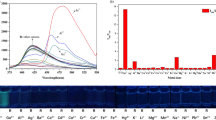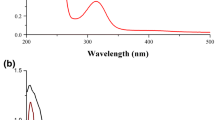Abstract
Here, we developed a novel isoniazid based fluorescent probe (E)-N’-(thiophen-2-ylmethylene)isonicotinohydrazide (TINH) through simple condensation reaction and employed for selective detection of Pd2+ ions with a low detection limit of 4.102 × 10–11 M. Among the many existing cations, TINH bound Pd2+ ions with an association affinity of 9.794 × 105 M−1. Adding Pd2+ ions to ligand solution increased the absorption intensity in UV–Visible and quenched the emission intensity in fluorescence spectroscopic experiments. More importantly, this TINH complexed to Pd2+ ions in 1:1 stoichiometric ratio. To evaluate the stability of complexed system, pH experiments has been performed. The binding insights among the ligand and Pd2+ ions has been confirmed by IR spectroscopic and MASS spectrometric methods. Additionally, TINH also applied to real water samples for the identification and measurement of Pd2+ ions. Hence, this system could be highly applicable for detection of Pd2+ ions in environmental and industrial samples with in low detection range.
Graphical Abstract










Similar content being viewed by others
Availability of Data and Materials
Data and materials are available on demand.
References
Maharramov AM, Mahmudov KT, Kopylovich MN, Pombeiro AJ (2016) Non-covalent interactions in the synthesis and design of new compounds. John Wiley & Sons
Kumar A, Saini M, Mohan B, Kamboj M (2022) Colorimetric and fluorescent Schiff base sensors for trace detection of pollutants and biologically significant cations: A review (2010–2021). Microchem J 107798
Qiu J, Jiang S, Lin B, Guo H, Yang F (2019) An unusual AIE fluorescent sensor for sequentially detecting Co2+-Hg2+-Cu2+ based on diphenylacrylonitrile Schiff-base derivative. Dyes Pigm 170:107590
Bregović VB, Basarić N (2015) Anion binding with urea and thiourea derivatives. Coord Chem Rev 295:80–124
Frost MC, Meyerhoff ME (2015) Real-time monitoring of critical care analytes in the bloodstream with chemical sensors: progress and challenges. Annu Rev Anal Chem 8:171–192
Volesky B (1990) Removal and recovery of heavy metals. Biosorption Heavy Met 7–43
Melentiev R, Yudhanto A, Tao R, Vuchkov T, Lubineau G (2022) Metallization of polymers and composites: State-of-the-art approaches. Mater Des 110958
Pawlak J, Łodyga-Chruścińska E, Chrustowicz J (2014) Fate of platinum metals in the environment. J Trace Elem Med Biol 28:247–254
Kielhorn J, Melber C, Keller D, Mangelsdorf I (2002) Palladium–a review of exposure and effects to human health. Int J Hyg Environ Health 205:417–432
Reşitoğlu İA, Altinişik K, Keskin A (2015) The pollutant emissions from diesel-engine vehicles and exhaust after-treatment systems. Clean Technol Environ Policy 17:15–27
Beletskaya IP, Alonso F, Tyurin V (2019) The Suzuki-Miyaura reaction after the Nobel prize. Coord Chem Rev 385:137–173
Fleckenstein CA, Plenio H (2007) 9-Fluorenylphosphines for the Pd-catalyzed sonogashira, suzuki, and buchwald–hartwig coupling reactions in organic solvents and water. Chem Eur J 13:2701–2716
Mahata S, Bhattacharya A, Kumar JP, Mandal BB, Manivannan V (2020) Naked-eye detection of Pd2+ ion using a highly selective fluorescent heterocyclic probe by “turn-off” response and in-vitro live cell imaging. J Photochem Photobiol, A 394:112441
Kumar A, Mohan B, Solovev AA, Saini M, Sharma HK (2022) Development of 2-hydroxy-naphthaldehyde functionalized Schiff base chemosensor for spectroscopic and colorimetric detection of Cu2+ and Pd2+ ions. Microchem J 180:107561
Song F, Garner AL, Koide K (2007) A highly sensitive fluorescent sensor for palladium based on the allylic oxidative insertion mechanism. J Am Chem Soc 129:12354–12355
Liang G, Cai Q, Zhu W, Xu Y, Qian X (2015) A highly selective heterogeneous fluorescent sensor for palladium ions. Anal Methods 7:4877–4880
Alqarni SA (2022) A review on conducting polymers for colorimetric and fluorescent detection of noble metal ions (Ag+, Pd2+, Pt2+/4+, and Au3+). Crit Rev Anal Chem 1–12
Wang R, Yu Z (2007) Validity and reliability of Benesi-Hildebrand method. Acta Phys Chim Sin 23:1353–1359
Zorn ME, Gibbons RD, Sonzogni WC (1999) Evaluation of approximate methods for calculating the limit of detection and limit of quantification. Environ Sci Technol 33:2291–2295
Prakash O, Hussain K, Aneja DK, Sharma C, Aneja KR (2011) A facile iodine (III)-mediated synthesis of 3-(3-aryl-1-phenyl-1 H-pyrazol-4-yl)-[1, 2, 4] triazolo [4, 3-a] pyridines via oxidation of 2-((3-aryl-1-phenyl-1 H-pyrazol-4-yl) methylene)-1-(pyridin-2-yl) hydrazines and their antimicrobial evaluations. Org Med Chem Lett 1:1–9
Chen S-Y, Li Z, Li K, Yu X-Q (2021) Small molecular fluorescent probes for the detection of lead, cadmium and mercury ions. Coord Chem Rev 429:213691
Yu C, Chen L, Zhang J, Li J, Liu P, Wang W, Yan B (2011) “Off-On” based fluorescent chemosensor for Cu2+ in aqueous media and living cells. Talanta 85(3):1627–1633
Aggarwal R, Kumar S, Kumar A, Mohan B, Sharma D, Kumar V (2022) Development of heterocyclic 2, 7-diamino-3-phenylazo-6-phenylpyrazolo [1, 5-a] pyrimidine as antimicrobial agent and selective probe for UV–visible and colorimetric detection of Hg2+ ions. Microchem J 183:107991
Renny JS, Tomasevich LL, Tallmadge EH, Collum DB (2013) Method of continuous variations: applications of job plots to the study of molecular associations in organometallic chemistry. Angew Chem Int Ed 52:11998–12013
Adak AK, Purkait R, Manna SK, Ghosh BC, Pathak S, Sinha C (2019) Fluorescence sensing and intracellular imaging of Pd2+ ions by a novel coumarinyl-rhodamine Schiff base. New J Chem 43:3899–3906
Mahapatra AK, Manna SK, Maiti K, Mondal S, Maji R, Mandal D, Mandal S, Uddin MR, Goswami S, Quah CK (2015) An azodye–rhodamine-based fluorescent and colorimetric probe specific for the detection of Pd2+ in aqueous ethanolic solution: synthesis, XRD characterization, computational studies and imaging in live cells. Analyst 140:1229–1236
Bhanja AK, Mishra S, Saha KD, Sinha C (2017) A fluorescence ‘turn-on’chemodosimeter for the specific detection of Pd2+ by a rhodamine appended Schiff base and its application in live cell imaging. Dalton Trans 46:9245–9252
Liu F, Du J, Xu M, Sun G (2016) A highly sensitive fluorescent sensor for palladium and direct imaging of its ecotoxicity in living model organisms. Chem Asian J 11:43–48
Huang Q, Zhou Y, Zhang Q, Wang E, Min Y, Qiao H, Zhang J, Ma T (2015) A new “off–on” fluorescent probe for Pd2+ in aqueous solution and live-cell based on spirolactam ring-opening reaction. Sens Actuators, B Chem 208:22–29
Chen Y, Chen B, Han Y (2016) A novel rhodamine-based fluorescent probe for the fluorogenic and chromogenic detection of Pd2+ ions and its application in live-cell imaging. Sens Actuators B Chem 237:1–7
Yang M, Bai Y, Meng W, Cheng Z, Su N, Yang B (2014) A novel selective fluorescent and colorimetric chemosensor for the visual detection of Pd2+ and application of imaging in living cells. Inorg Chem Commun 46:310–314
Li H, Fan J, Song F, Zhu H, Du J, Sun S, Peng X (2010) Fluorescent probes for Pd2+ detection by allylidene–hydrazone ligands with excellent selectivity and large fluorescence enhancement. Chem Eur J 16:12349–12356
Wu H, Lin L, Zheng L, Guo H, Yang F (2022) Dual-response fluorescence sensor for detecting Cu2+ and Pd2+ based on bis-tetraphenylimidazole Schiff-base. J Photochem Photobiol A 432:114076
Kang M, Jiang S, Liu Y, Wei K, Liu P, Yang X, Pei M, Zhang G (2023) A new “off-on-off” Schiff base from quinoline and thiophene as a fluorescent sensor for sequential monitoring Ga3+ and Pd2+. J Photochem Photobiol A 438:114510
Zhou W, Gao Q, Liu D, Li C, Liu S, Xia K, Han B, Zhou C (2020) A single molecular sensor for selective and differential colorimetric/ratiometric detection of Cu2+ and Pd2+ in 100% aqueous solution. Spectrochim Acta Part A Mol Biomol Spectrosc 237:118365
Chen H, Jin X, Lu H, Shen W (2018) A new rhodamine B-based ‘off-on’colorimetric chemosensor for Pd2+ and its imaging in living cells. Inorg Chim Acta 482:122–129
Mohan B, Kumar S, Modi K, Deshmukh AH, Kumar A (2021) 2-((E)-1-((E)-(2-methoxybenzylidene) hydrazono) ethyl) phenol based cost-effective sensor for the selective detection of Eu3+ ions. Polyhedron 209:115460
Chakraborty P, Rana A, Mukherjee S, Biswas S (2022) Metal–organic-framework-based chemosensor for ultrafast and ultrasensitive detection of Pd2+ ions in water, real specimens, and test strips. Inorg Chem 62(2):802–809
Acknowledgements
The authors are thankful to the Department of chemistry, Baba Mastnath University, Asthal Bohar, Rohtak and the Department of chemistry, Kurukshetra University, Kurukshetra (India), for providing spectral facilities, including NMR spectroscopy.
Funding
There is no funding for this work.
Author information
Authors and Affiliations
Contributions
Jasbir Singh: Conceptualization, Investigation, Experimental, Resources, Formal analysis; Shubham Saini: Experimental, Formal analysis & Editing; Ravish K. Chauhan: Resources, Formal analysis; Writing- Original draft preparation; Pallavi Bhardwaj: Conceptualization, Investigation, Resources, Formal analysis; Ashwani Kumar: Writing- Original draft preparation, Formal analysis; Virender: Experimental, Writing- Original draft preparation, Formal analysis.
Corresponding authors
Ethics declarations
Ethical Approval
No such data applies to human and/ or animal studies. This work is a novel and has not been published in any journal or thesis work.
Competing Interests
The authors declare no competing interests.
Additional information
Publisher's Note
Springer Nature remains neutral with regard to jurisdictional claims in published maps and institutional affiliations.
Supplementary Information
Below is the link to the electronic supplementary material.
Rights and permissions
Springer Nature or its licensor (e.g. a society or other partner) holds exclusive rights to this article under a publishing agreement with the author(s) or other rightsholder(s); author self-archiving of the accepted manuscript version of this article is solely governed by the terms of such publishing agreement and applicable law.
About this article
Cite this article
Singh, J., Saini, S., Chauhan, R.K. et al. An Isoniazid Based Schiff Base Sensor for Selective Detection of Pd2+ Ions. J Fluoresc (2023). https://doi.org/10.1007/s10895-023-03491-x
Received:
Accepted:
Published:
DOI: https://doi.org/10.1007/s10895-023-03491-x




